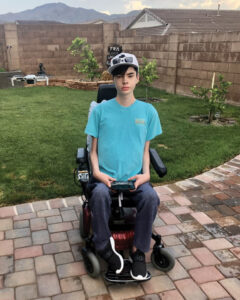 by Paul Winn, Brain & Life. Reposted with permission.
by Paul Winn, Brain & Life. Reposted with permission.
Sam Ray, a 15-year-old, in Tucson, AZ, talks to our writer Paul Wynn about how his rare disease motivated him to explore exoskeleton technology.
Smiling and laughing are easy for most people, but not for me. It’s not because I’m unhappy. It’s because I have facioscapulohumeral muscular dystrophy (FSHD), a rare genetic disease characterized by progressive skeletal muscle loss that usually begins in the face, shoulders, and arms and eventually causes weakness in the legs. People with FSHD typically begin experiencing symptoms during their teens or early adulthood, but in unusual cases like mine the symptoms appear in early childhood.
I met all my developmental milestones until I was about 3, when my preschool teachers detected hearing loss, which is an early sign of the condition. I saw speech therapists for eight years to address my hearing problems. One of the therapists told my mother that she had noticed a facial-type paralysis, as if the muscles in my face were freezing up.
When I was 6, my pediatrician referred me to a neurologist, who ordered some blood tests, which came back positive for FSHD. The disease hasn’t affected my cognitive function, but it has had a profound effect on my strength and mobility. At age 8 my legs started to weaken, so I wore leg braces. I also had two surgeries on my left foot to keep it from dropping and rolling to the side, and back surgery to fuse my spine to correct severe scoliosis. Today I use a wheelchair, and my arms and hands are so weak I can’t feed myself.
For the past four years—I’m now 15—I’ve been tinkering with mobility devices. When I was 11, my friend and I built a makeshift exoskeleton out of cardboard and rubber bands for my arm to help me lift things. We got third place in the county science fair.
After touring an exoskeleton facility through the Make-A-Wish Foundation, I tried building an exoskeleton again with help from scientists, who sent me a 3D-printed mold for my bicep and forearm. I attached a motor and rubber bands to the mold, which helped me lift my hand to my face. Doing these experiments taught me a lot about my disease and how the future for the physically disabled can be improved with exoskeleton technology.
I’m also working with the Muscular Dystrophy Association (MDA) in Arizona. When I was a patients’ representative, I spoke at events to raise awareness about the infantile form of the disease. My family and friends have helped me raise more than $20,000 for MDA during its annual walk in Tucson. The money supports research to find cures and send kids like me to the MDA summer camp—something I look forward to each year. The camp has been virtual the past two years, but I’m really hoping we can return next summer.
Currently my mom and I are directors of the Arizona chapter of the FSHD Society. Through this volunteer work, I’ve been more involved with fundraising to find a cure—and ultimately help me and others with FSHD smile more easily.
Credits: Story by Paul Wynn, reposted with permission. Read the original post here.


Wow, Sam. You are a really fantastic young man!
Congratulations Sam! What you have accomplished goes beyond words!!! I am 45 years old with severe FSHD and mother of a 1,5 year old son. Thank you for all the hard work you have been doing. You are such a strong young man!!!
Congratulations Sam! You have accomplished so much in such a young age! Thank you for sharing with us.
Dear Sam,
Thank you for your thoughtfulness and consideration in using your smarts to create exoskeletons. Your a very handsome young man. Both my son and I have FSHD and that exterior smile issue however we as you smile on the inside and people can see your resilience.
You will be in our prayers.
Blessings